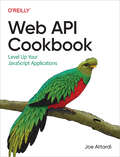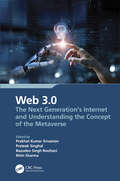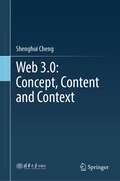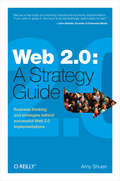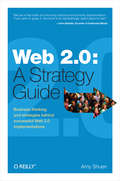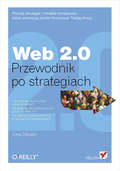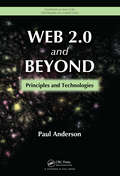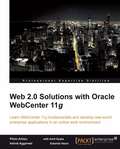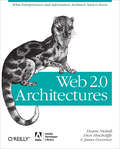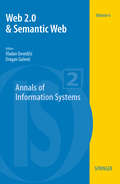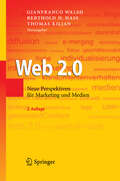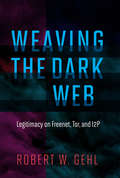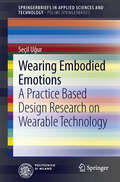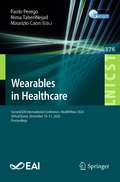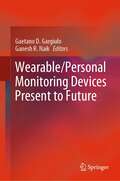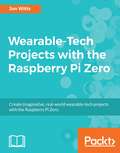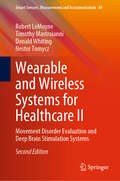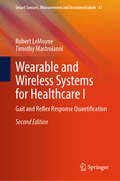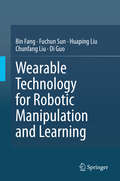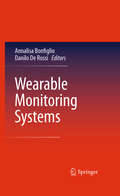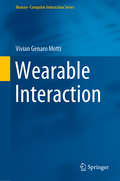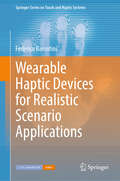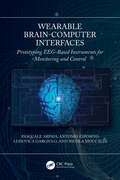- Table View
- List View
Web API Cookbook: Level Up Your JavaScript Applications
by Joe AttardiJavaScript gives web developers great power to create rich interactive browser experiences, and much of that power is provided by the browser itself. Modern web APIs enable web-based applications to come to life like never before, supporting actions that once required browser plug-ins. Some are still in an experimental stage, but many are ready for use today.With this hands-on cookbook, author Joe Attardi helps you explore the powerful APIs available in modern browsers and guides you through the specific tasks that they unlock. Because these features are web standards, there is comprehensive documentation available from trusted resources such as MDN Web Docs. The knowledge you'll gain is transferable across different companies and projects.Learn the breadth of functionality available in modern browser APIsExplore future APIs that are still in an experimental stageDiscover newer elements, such as dialog that replaces the need for a third-party libraryBuild more powerful and interactive web applications using native APIsUnderstand the permissions model used by the browser to unlock functionality such as geolocation and push notifications
Web 3.0: The Next Generation's Internet and Understanding the Concept of the Metaverse
by Prateek Singhal Prabhat Kumar Srivastav Basudeo Singh Roohani Nitin SharmaThe book underscores AI's transformative impact on reshaping physical, digital, and biological boundaries, converging with technologies like robotics, IoT, 3D printing, genetic engineering, and quantum computing—termed Web 3.0 Industrial Revolution. This global revolution integrates advanced production techniques beyond connected machines, extending into gene sequencing, nanotechnology, renewable energies, and quantum computing. The book's main goals include providing a collaborative platform for academia and industry researchers to share contributions and shape the future through knowledge exchange. Recognizing recent progress driven by increased computing power, it highlights the positive impact of digital technology—AI, IoT, AR/VR, Additive Manufacturing, CPS, cloud computing, and robotics—on industrial efficiency and quality. Revolutionary AI Fusion: AI revolutionizes by blending physical, digital, and biological boundaries through cutting-edge technologies like robotics, IoT, 3D printing, genetic engineering, and quantum computing. Global Manufacturing Cooperation: AI creates a collaborative landscape where virtual and physical systems flexibly cooperate on a global scale. AI's Diverse Impact: Beyond smart machines, AI drives breakthroughs in gene sequencing, nanotechnology, renewable energies, and quantum computing, distinguishing it from prior industrial revolutions. Progress and Digital Interface: Recent progress, powered by computing advancements, boosts industrial efficiency. The digital technology interface (AI, IoT, AR/VR, 3D Printing, CPS, CC, Robotics) significantly impacts industrial performance. In conclusion, AI spearheads a transformative revolution, redefining the boundaries of the physical, digital, and biological realms. The fusion of AI with Web 3.0 Industrial Revolution, integrating advanced production techniques and global manufacturing cooperation, surpassing past industrial shifts. The book aims to be a collaborative platform for academia and industry researchers, fostering knowledge exchange to shape the future. In AI-driven manufacturing within Web 3.0, a paradigm shift envisions maximum output with minimal resource use. Coupled with 'Digital Reality,' it transforms business practices, consumer behaviour, and employment dynamics, redistributing wealth toward innovation and technology.
Web 3.0: Concept, Content and Context
by Shenghui ChengAs technology continues to advance, the Internet is evolving into what is often referred to as Web 3.0. This book aims to achieve three main objectives, first, it introduces Web 3.0 systematically and comprehensively, providing readers with a foundational understanding of its concepts and characteristics. Second, it analyzes the inevitability and development necessity of Web 3.0, as well as its potential future possibilities and transformative effects. Finally, it explores Web 3.0 through comparative analysis, discussing its relationship with the metaverse as well as how individuals and organizations can seize the opportunities presented by Web 3.0. Various topics related to Web 3.0, including its infrastructure, development facilities, scenario applications, technology stacks, and industry applications such as decentralized applications (DApps) and Software-as-a-Service (SaaS) platforms are presented in the book. It delves into the ecosystem of Web 3.0, discussing decentralized autonomous organizations (DAOs), open finance (DeFi), cryptocurrencies, token economy, digital identity, creator economy, attention economy, and cyber-physical and human systems. Additionally, it addresses governance issues, security challenges, development challenges, and legal and regulatory aspects associated with Web 3.0. Overall, Web 3.0: Concept, Content and Context provides readers with a comprehensive understanding of Web 3.0, its potential implications, and the opportunities for new industry models and business opportunities in the evolving Internet era.
Web 2.0: Business thinking and strategies behind successful Web 2.0 implementations.
by Amy ShuenWeb 2.0 makes headlines, but how does it make money? This concise guide explains what's different about Web 2.0 and how those differences can improve your company's bottom line. Whether you're an executive plotting the next move, a small business owner looking to expand, or an entrepreneur planning a startup, Web 2.0: A Strategy Guide illustrates through real-life examples how businesses, large and small, are creating new opportunities on today's Web. This book is about strategy. Rather than focus on the technology, the examples concentrate on its effect. You will learn that creating a Web 2.0 business, or integrating Web 2.0 strategies with your existing business, means creating places online where people like to come together to share what they think, see, and do. When people come together over the Web, the result can be much more than the sum of the parts. The customers themselves help build the site, as old-fashioned "word of mouth" becomes hypergrowth.Web 2.0: A Strategy Guide demonstrates the power of this new paradigm by examining how: Flickr, a classic user-driven business, created value for itself by helping users create their own value Google made money with a model based on free search, and changed the rules for doing business on the Web-opening opportunities you can take advantage ofSocial network effects can support a business-ever wonder how FaceBook grew so quickly? Businesses like Amazon tap into the Web as a source of indirect revenue, using creative new approaches to monetize the investments they've made in the Web Written by Amy Shuen, an authority on Silicon Valley business models and innovation economics, Web 2.0: A Strategy Guide explains how to transform your business by looking at specific practices for integrating Web 2.0 with what you do. If you're executing business strategy and want to know how the Web is changing business, this book is for you.
Web 2.0: Business Thinking and Strategies Behind Successful Web 2.0 Implementations
by Amy ShuenWeb 2.0 makes headlines, but how does it make money? This concise guide explains what's different about Web 2.0 and how those differences can improve your company's bottom line. Whether you're an executive plotting the next move, a small business owner looking to expand, or an entrepreneur planning a startup, Web 2.0: A Strategy Guide illustrates through real-life examples how businesses, large and small, are creating new opportunities on today's Web.This book is about strategy. Rather than focus on the technology, the examples concentrate on its effect. You will learn that creating a Web 2.0 business, or integrating Web 2.0 strategies with your existing business, means creating places online where people like to come together to share what they think, see, and do. When people come together over the Web, the result can be much more than the sum of the parts. The customers themselves help build the site, as old-fashioned "word of mouth" becomes hypergrowth.Web 2.0: A Strategy Guide demonstrates the power of this new paradigm by examining how: Flickr, a classic user-driven business, created value for itself by helping users create their own valueGoogle made money with a model based on free search, and changed the rules for doing business on the Web-opening opportunities you can take advantage ofSocial network effects can support a business-ever wonder how FaceBook grew so quickly?Businesses like Amazon tap into the Web as a source of indirect revenue, using creative new approaches to monetize the investments they've made in the WebWritten by Amy Shuen, an authority on Silicon Valley business models and innovation economics, Web 2.0: A Strategy Guide explains how to transform your business by looking at specific practices for integrating Web 2.0 with what you do. If you're executing business strategy and want to know how the Web is changing business, this book is for you.
Web 2.0. Przewodnik po strategiach
by Amy ShuenPoznaj strategie i modele biznesowe, które podnios? wyniki finansowe Twojej firmy! Jak zarabia?, dostarczaj?c us?ugi za darmo?Jak stworzy? dochodowy biznes, oparty na Web 2.0?Jak w??czy? strategie Web 2.0 w istniej?ce przedsi?wzi?cie?Je?li my?lisz, ?e Web 2.0 to wy??cznie technologia budowy interaktywnych portali internetowych, jeste? w b??dzie. Web 2.0 to rewolucja! To nowy sposób komunikacji przez internet, umo?liwiaj?cy u?ytkownikom wspólne tworzenie witryny i dzielenie si? wiedz?. Dzi?ki efektom sieci Web 2.0 staje si? ?ród?em okazji biznesowych. Jest miejscem, gdzie zaawansowana technologia ??czy si? z biznesem i gdzie -- udost?pniaj?c us?ugi za darmo -- mo?esz zarabia?. Web 2.0 przyjmuje bowiem fundamentalnie odmienny punkt widzenia na relacje mi?dzy biznesem, klientami i partnerami, a wi?c udost?pnia nam wszystkim nowe modele biznesowe. Ksi??ka "Web 2.0. Przewodnik po strategiach" zawiera omówienie wszystkich potrzebnych w biznesie technik i narz?dzi analitycznych, co sk?ada si? na ogólny obraz ekonomii opartej na Web 2.0. Z tego podr?cznika dowiesz si?, jak powstaj? efekty sieci, w jaki sposób prowokowa? i wykorzystywa? okazje biznesowe oraz zarabia? pieni?dze na dostarczonych przez u?ytkowników warto?ciach. Uwierzysz, ?e za pomoc? Web 2.0 mog? bogaci? si? i korporacje, i niewielkie przedsi?biorstwa. Poznasz sprawdzone narz?dzia i strategie oraz rewolucyjne modele biznesowe, stosowane przez takie firmy, jak Google czy Amazon. Pami?taj, ?e tym firmom przynios?y one wielki sukces i ogromne zyski.Wspólna warto?? u?ytkowników portalu Odkrywanie i wykorzystywanie grup internetowychPozytywne efekty sieciowe w Web 2.0Spieni??anie sieci spo?ecznychKoszty pozyskania klienta i szybko?? wzrostu zysku z reklamTworzenie warto?ci w sieciach spo?ecznychRozwijanie zdolno?ci adaptacyjnych przez Web 2.0Style innowacjiTworzenie biznesplanów Web 2.0 Przy??cz si? do rewolucji Web 2.0 i zarabiaj w internecie Wyró?nienie Magazynu Literackiego KSI??KIRedakcja Magazynu Literackiego KSI??KI przyzna?a ksi??ce "Web 2.0 - przewodnik po strategiach" w kwietniu 2009 roku Wyró?nienie za ksi??k? miesi?ca w kategorii Ekonomia http://helion.pl/img/rozne/wyd/wyd7_6.jpg" />
Web 2.0 and Beyond: Principles and Technologies (Chapman & Hall/CRC Textbooks in Computing)
by Paul AndersonWeb 2.0 and Beyond: Principles and Technologies draws on the author's iceberg model of Web 2.0, which places the social Web at the tip of the iceberg underpinned by a framework of technologies and ideas. The author incorporates research from a range of areas, including business, economics, information science, law, media studies, psychology, social
Web 2.0 Solutions with Oracle WebCenter 11g
by Plinio Arbizu Ashok AggarwalThe book starts by explaining the context of the WEB 2.0 platform. It helps the reader to understand its main features and their application in organizations. It shows how the Oracle WebCenter technology can help you implement the Web 2.0 solutions. In each chapter, the theoretical concepts are tested with the help of practical applications. The apt recommendations and suggestions are other key points of the book. Filled with careful step-by-step instructions and plenty of screenshots, this tutorial shows you how to get the most out of the WebCenter Suite 11g. You will learn about integrating various services to enhance your Web 2.0 solutions using Oracle WebCenter. This book is for web developers who need to improve their websites or business applications using Web 2.0 features. This book is recommended for you, if you are a: Portal Developer who works with a traditional portal and wants to move onto new technologies Java Developer and want to add productivity features to your business applications Knowledge Managers and want to create collaborative environments and increase the productivity of your employees and organizational groups
Web 2.0 Architectures: What entrepreneurs and information architects need to know
by Dion Hinchcliffe Duane Nickull James GovernorWeb 2.0 is more pervasive than ever, with business analysts and technologists struggling to comprehend the opportunity it represents. So what exactly is Web 2.0 -- a marketing term or technical reality? This fascinating book finally puts substance behind the phenomenon by identifying the core patterns of Web 2.0, and by introducing an abstract model and reference architecture to help you take advantage of them.In Web 2.0 Architectures, authors Duane Nickull, Dion Hinchcliffe, and James Governor -- who have 40 years of combined experience with technical specifications and industry trends -- examine what makes successful Web 2.0 services such as Google AdSense, Flickr, BitTorrent, MySpace, Facebook, and Wikipedia work. The result is a base of knowledge that developers, business people, futurists, and entrepreneurs can understand and use as a source of ideas and inspiration. This book reveals:A Web 2.0 model: How the classic Client-Server model evolved into a more detailed Web 2.0 model.Web 2.0 reference architecture: A generic component view of basic Web 2.0 patterns that can be repurposed for other commercial ventures.Specific Web 2.0 patterns: How service oriented architecture (SOA), Software as a Service (SaaS), participation-collaboration, mashups, rich user experience, collaborative tagging systems (Folksonomy), and more can be used in your business.If you want to understand what makes Web 2.0 tick, and how it will enhance your business, Web 2.0 Architectures takes you right to the core.
Web 2.0 & Semantic Web
by Dragan Gaševic Vladan DevedžicWeb 2.0 describes the trend in Web technology and design that aims to enhance creativity, information sharing, and, especially, collaboration among users. Semantic Web refers to the intelligent interaction among systems and applications on the Web by deploying ontologies, semantic annotation of Web content, and reasoning. Its ultimate goal is to make data understandable to computers, and thus open to far greater utility and manipulation. This special issue of AoIS presents cutting-edge research on both of these often opposed trends in computing and will support discussion on both the synergies and controversies inherent in the two technologies, while also considering what other technologies can contribute to both. Dramatic advances in service-oriented architectures, model-driven engineering, and Web mining technologies are but a few of the developments that might have a considerable impact on both Web 2.0 and Semantic Web, and they will all be covered in this volume.
Web 2.0
by Berthold H. Hass Gianfranco Walsh Thomas KilianNeue Technologien und Nutzungsarten machen das Internet interaktiver, neue Formen des Austauschs sind möglich geworden. So gestalten Nutzer Ideen und Produkte mit und werden zu wichtigen Wertschöpfungspartnern von Unternehmen. Dies zeigt, dass Web 2.0 mehr ist als nur ein neuer Internet-Hype. Der Band bietet eine praxisorientierte Einführung und einen systematischen Einblick in aktuelle Konzepte und Trends. Renommierte Autoren aus Wissenschaft und Praxis stellen neue Entwicklungen und praktische Anwendungen für Web 2.0 vor.
Weaving the Dark Web: Legitimacy on Freenet, Tor, and I2P (The Information Society Series)
by Robert W. GehlAn exploration of the Dark Web—websites accessible only with special routing software—that examines the history of three anonymizing networks, Freenet, Tor, and I2P.The term “Dark Web” conjures up drug markets, unregulated gun sales, stolen credit cards. But, as Robert Gehl points out in Weaving the Dark Web, for each of these illegitimate uses, there are other, legitimate ones: the New York Times's anonymous whistleblowing system, for example, and the use of encryption by political dissidents. Defining the Dark Web straightforwardly as websites that can be accessed only with special routing software, and noting the frequent use of “legitimate” and its variations by users, journalists, and law enforcement to describe Dark Web practices (judging them “legit” or “sh!t”), Gehl uses the concept of legitimacy as a window into the Dark Web. He does so by examining the history of three Dark Web systems: Freenet, Tor, and I2P.Gehl presents three distinct meanings of legitimate: legitimate force, or the state's claim to a monopoly on violence; organizational propriety; and authenticity. He explores how Freenet, Tor, and I2P grappled with these different meanings, and then discusses each form of legitimacy in detail by examining Dark Web markets, search engines, and social networking sites. Finally, taking a broader view of the Dark Web, Gehl argues for the value of anonymous political speech in a time of ubiquitous surveillance. If we shut down the Dark Web, he argues, we lose a valuable channel for dissent.
Wearing Embodied Emotions
by Seçil UğurToday, people are in an era of digitally mediated Human-to-Human Interaction, which cannot provide full sensorial contact and therefore, emotions cannot be communicated completely. The intimate cover of the human body, i.e. garment is the interface, where many personal traits are embodied. With the improvements in textile and electronics industry, this embodiment can be carried on a higher level, where the garments become dynamic interfaces and extensions of the human body. This book consists of a research on skin, clothes and technology as extensions of human body, emotions, technology-mediated emotions and a design practice that explores the communicative level of wearable technology through turning it into a living surface, which can convert intangible data to tangible in order to provide an emotional communication. This book aims to show how Human-Technology interaction is carried into an alternative context, where technology dissolves in use and starts serving for enhancing HHI.
Wearables in Healthcare: Second EAI International Conference, HealthWear 2020, Virtual Event, December 10-11, 2020, Proceedings (Lecture Notes of the Institute for Computer Sciences, Social Informatics and Telecommunications Engineering #376)
by Paolo Perego Nima TaheriNejad Maurizio CaonThis book constitutes the refereed post-conference proceedings of the Second EAI International Conference on Wearables in Healthcare, HealthWear 2020. Due to COVID-19 pandemic the conference was held virtually. The 16 revised full papers were carefully reviewed and selected from 40 submissions. They focus on wearable devices and systems for healthcare and wellbeing. The papers are organized in topical sections as follows: PPG and algorithms focusing on photoplethysmography, PPG monitoring and cardiorespiratory measurement. The next section focus on IoT and smart sensors on the use of wearable devices and systems for Internet of Medical Things application. The third section is a new session introducing wearable applications. This track focuses on the intrinsic multidisciplinary of wearable devices, and includes works on methodology and design aspect of wearable research.
Wearable/Personal Monitoring Devices Present to Future
by Ganesh R. Naik Gaetano D. GargiuloThis book discusses recent advances in wearable technologies and personal monitoring devices, covering topics such as skin contact-based wearables (electrodes), non-contact wearables, the Internet of things (IoT), and signal processing for wearable devices. Although it chiefly focuses on wearable devices and provides comprehensive descriptions of all the core principles of personal monitoring devices, the book also features a section on devices that are embedded in smart appliances/furniture, e.g. chairs, which, despite their limitations, have taken the concept of unobtrusiveness to the next level. Wearable and personal devices are the key to precision medicine, and the medical community is finally exploring the opportunities offered by long-term monitoring of physiological parameters that are collected during day-to-day life without the bias imposed by the clinical environment. Such data offers a prime view of individuals’ physical condition, as well as the efficacy of therapy and occurrence of events. Offering an in-depth analysis of the latest advances in smart and pervasive wearable devices, particularly those that are unobtrusive and invisible, and addressing topics not covered elsewhere, the book will appeal to medical practitioners and engineers alike.
Wearable-Tech Projects with the Raspberry Pi Zero
by Jon WittsLeverage the cheapest and smallest computer to build exciting wearable-tech projects. About This Book • A practical and imaginative guide that exposes you to amazing wearable-tech projects • Create our own heart-rate monitor device and cool projects such as a Tweet-activated LED T-shirt • A practical guide packed with real-world, useful wearable-tech projects Who This Book Is For Everyone. While some prior knowledge of Python programming and use of the terminal on the Raspberry Pi would be advantageous, they are by no means necessary. Each chapter clearly sets the steps to be taken on your wearable-tech adventure. The first chapter assumes no prior knowledge to get your Pi Zero and you, up and running. The complexity of the electronic devices used, progress incrementally as you work through the chapters; there are clear steps to follow and pictures to help you at every turn along the way. What You Will Learn • Make use of your Raspberry Pi Zero to create wearable-tech projects • Interface with electronic devices and use Python to control them; incorporate these into real-world, practical, wearable-tech projects • Add LED devices to clothing and connect them to your Pi Zero • Change how LEDs react based upon your movement or messages sent through Twitter • Create a pedometer and heart rate monitor • Create your own GPS tracker In Detail With Wearable-Tech Projects with the Raspberry Pi Zero, you will begin with learning how to install the required software for your upcoming projects. You will also learn how to control electronic devices with the GPIOZero Python library. Next, you will be creating some stylish wearable-tech projects such as a motion-reactive LED cap and a Tweet-activated LED T-shirt. Toward the end of the book, you will be creating some useful health and fitness wearable-tech projects; these will help you monitor your heart rate, track your movements with GPS, and count your footsteps with your own pedometer. By the end of the book, you will have created a range of wearable-tech projects and learned enough about your Raspberry Pi Zero that you should be able to adapt these projects further or come up with your own creations! Style and approach This book showcases interesting and cool projects that use the Raspberry Pi Zero in wearable-tech. This book is for readers who are looking to progress to the next level of integrating hardware into their projects. Upon completion of each project, you will have a functional device that can be worn either to enhance your style or to provide you with practical data.
Wearable and Wireless Systems for Healthcare II: Movement Disorder Evaluation and Deep Brain Stimulation Systems (Smart Sensors, Measurement and Instrumentation #49)
by Timothy Mastroianni Robert LeMoyne Donald Whiting Nestor TomyczThis book is the second edition of the one originally published in 2019. The original publication features the discovery of numerous novel applications for the use of smartphones and portable media devices for the quantification of deep brain stimulation for the treatment of movement disorders that constitute first-in-the-world applications for these devices. Since the first edition, numerous evolutions involving the domain of wearable and wireless systems for healthcare and deep brain stimulation have transpired warranting the publication of the second edition. This volume covers wearable and wireless systems for healthcare that are far more relevant to the unique requirements of the domain of deep brain stimulation. The paradigm-shifting new wearables comprising attributes of conformability and further miniaturization have been recently applied for the context of deep brain stimulation. Additionally, the subjects of automated optimization for deep brain stimulation and the rampantly expanding additional applications for deep brain stimulation are addressed. The authors expect that these significant developments make this book valuable for all readers.
Wearable and Wireless Systems for Healthcare I: Gait and Reflex Response Quantification (Smart Sensors, Measurement and Instrumentation #47)
by Timothy Mastroianni Robert LeMoyneThis book is the second edition of the one originally published in 2017. The original publication features the discovery of numerous novel applications for the use of smartphones and portable media devices for the quantification of gait, reflex response, and an assortment of other concepts that constitute first-in-the-world applications for these devices. Since the first edition, numerous evolutions involving the domain of wearable and wireless systems for healthcare have transpired warranting the publication of the second edition. This volume covers wearable and wireless systems for healthcare that are far more oriented to the unique requirements of the biomedical domain. The paradigm-shifting new wearables have been successfully applied to gait analysis, homebound therapy, and quantifiable exercise. Additionally, the confluence of wearable and wireless systems for healthcare with deep learning and neuromorphic applications for classification is addressed. The authors expect that these significant developments make this book valuable for all readers.
Wearable Technology for Robotic Manipulation and Learning
by Huaping Liu Fuchun Sun Bin Fang Chunfang Liu Di GuoOver the next few decades, millions of people, with varying backgrounds and levels of technical expertise, will have to effectively interact with robotic technologies on a daily basis. This means it will have to be possible to modify robot behavior without explicitly writing code, but instead via a small number of wearable devices or visual demonstrations. At the same time, robots will need to infer and predict humans’ intentions and internal objectives on the basis of past interactions in order to provide assistance before it is explicitly requested; this is the basis of imitation learning for robotics. This book introduces readers to robotic imitation learning based on human demonstration with wearable devices. It presents an advanced calibration method for wearable sensors and fusion approaches under the Kalman filter framework, as well as a novel wearable device for capturing gestures and other motions. Furthermore it describes the wearable-device-based and vision-based imitation learning method for robotic manipulation, making it a valuable reference guide for graduate students with a basic knowledge of machine learning, and for researchers interested in wearable computing and robotic learning.
Wearable Robotics: Proceedings of the 5th International Symposium on Wearable Robotics, WeRob2020, and of WearRAcon Europe 2020, October 13–16, 2020 (Biosystems & Biorobotics #27)
by Juan C. Moreno Jawad Masood Urs Schneider Christophe Maufroy Jose L. PonsThis book reports on advanced topics in the areas of wearable robotics research and practice. It focuses on new technologies, including neural interfaces, soft wearable robots, sensors and actuators technologies, discussing industrially and medically-relevant issues, as well as legal and ethical aspects. It covers exemplary case studies highlighting challenges related to the implementation of wearable robots for different purposes, and describing advanced solutions. Based on the 5th International Symposium on Wearable Robotics, WeRob2020, and on WearRacon Europe 2020, which were both held online on October 13-16, 2020, the book addresses a large audience of academics and professionals working in for the government, in the industry, and in medical centers, as well as end-users alike. By merging together engineering, medical, ethical and industrial perspectives, it offers a multidisciplinary, timely snapshot of the field of wearable technologies.
Wearable Robotics: Proceedings of the 4th International Symposium on Wearable Robotics, WeRob2018, October 16-20, 2018, Pisa, Italy (Biosystems & Biorobotics #22)
by José L. Pons Maria Chiara Carrozza Silvestro MiceraThe book reports on advanced topics in the areas of wearable robotics research and practice. It focuses on new technologies, including neural interfaces, soft wearable robots, sensors and actuators technologies, and discusses important regulatory challenges, as well as clinical and ethical issues. Based on the 4th International Symposium on Wearable Robotics, WeRob2018, held October 16-20, 2018, in Pisa, Italy, the book addresses a large audience of academics and professionals working in government, industry, and medical centers, and end-users alike. It provides them with specialized information and with a source of inspiration for new ideas and collaborations. It discusses exemplary case studies highlighting practical challenges related to the implementation of wearable robots in a number of fields. One of the focus is on clinical applications, which was encouraged by the colocation of WeRob2018 with the International Conference on Neurorehabilitation, INCR2018. Additional topics include space applications and assistive technologies in the industry. The book merges together the engineering, medical, ethical and political perspectives, thus offering a multidisciplinary, timely snapshot of the field of wearable technologies.
Wearable Monitoring Systems
by Annalisa Bonfiglio Danilo De RossiAs diverse as tomorrow's society constituent groups may be, they will share the common requirements that their life should become safer and healthier, offering higher levels of effectiveness, communication and personal freedom. The key common part to all potential solutions fulfilling these requirements is wearable embedded systems, with longer periods of autonomy, offering wider functionality, more communication possibilities and increased computational power. As electronic and information systems on the human body, their role is to collect relevant physiological information, and to interface between humans and local and/or global information systems. Within this context, there is an increasing need for applications in diverse fields, from health to rescue to sport and even remote activities in space, to have real-time access to vital signs and other behavioral parameters for personalized healthcare, rescue operation planning, etc. This book's coverage will span all scientific and technological areas that define wearable monitoring systems, including sensors, signal processing, energy, system integration, communications, and user interfaces. Six case studies will be used to illustrate the principles and practices introduced.
Wearable Interaction (Human–Computer Interaction Series)
by Vivian Genaro MottiThis book offers the reader a comprehensive view of the design space of wearable computers, cutting across multiple application domains and interaction modalities. Besides providing several examples of wearable technologies, Wearable Interaction illustrates how to create and to assess interactive wearables considering human factors in design decisions related to input entry and output responses. The book also discusses the impacts of form factors and contexts of use in the design of wearable interaction. Miniaturized components, flexible materials, and sewable electronics toolkits exemplify advances in technology that facilitated the design and development of wearable technologies. Despite such advances, creating wearable interfaces that are efficient is still challenging. The new affordances of on-body interfaces require the consideration of new interaction paradigms, so that the design decisions for the user interaction take into account key limitations in the interaction surfaces of wearables concerning input entry, processing power for output responses, and in the time and attention that wearers dedicate to complete their interaction. Under such constraints, creating interfaces with high usability levels is complex. Also, because wearables are worn continuously and in close contact with the human body, on-body interfaces must be carefully designed to neither disturb nor overwhelm wearers. The context of use and the potential of wearable technologies must be both well understood to provide users with relevant information and services using appropriate approaches and without overloading them with notifications. Wearable Interaction explains thoroughly how interactive wearables have been created taking into account the needs of end users as well as the vast potential that wearable technologies offer. Readers from academia, industry or government will learn how wearables can be designed and developed to facilitate human activities and tasks across different sectors.
Wearable Haptic Devices for Realistic Scenario Applications (Springer Series on Touch and Haptic Systems)
by Federica BarontiniThis book delves into the application of wearable haptic feedback technology in various contexts, focusing on prosthetics for individuals with upper limb loss and navigation systems for the visually impaired. Central to the book is the development of technologies that address users' needs and demands. It highlights the pivotal role of a user-centred approach in designing and creating novel feedback mechanisms. Beginning with focus groups and experimental campaigns, each chapter introduces innovative haptic devices that are characterized, tested, and refined to consistently meet user requirements. The research culminates in the creation of a fully integrated feedback system within a prosthetic socket. This book provides comprehensive insights into developing practical, user-friendly haptic devices that significantly improve the quality of life for individuals with sensory impairments.
Wearable Brain-Computer Interfaces: Prototyping EEG-Based Instruments for Monitoring and Control
by Antonio Esposito Pasquale Arpaia Nicola Moccaldi Ludovica GargiuloThis book presents a complete overview of the main EEG-based Brain-Computer Interface (BCI) paradigms and the related practical solutions for their design, prototyping, and testing. Readers will explore active, reactive, and passive BCI paradigms, with an emphasis on the operation for developing solutions, addressing the need for customization. Readers will familiarize themselves with the main steps for the realization of low-cost wearable BCIs which include: identification of the most suitable neuro signals for a specific application; definition of the hardware, firmware, and software, with a focus on wearable, non-invasive, and low-cost solutions; development of algorithms for data processing and classification; and, lastly, experimental campaigns for the validation of the prototyped solutions. BCI systems based on electroencephalography (EEG) are investigated and a complete overview of all BCI paradigms is offered. The aim of this book is to drive the reader, from the beginning to the end, along a research-and-development process of a working BCI prototype. This book is a guide for designers, biomedical engineers, students, biotechnologists, and those in the biomedical instrumentation field that would like to conceive, design, prototype, and test an innovative low-cost wearable EEG-based BCI.
